 |

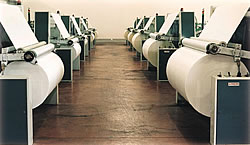 BATCHER FOR FABRIC MOD. “TCX-A”
BATCHER FOR FABRIC MOD. “TCX-A” Batcher for axial winding with drive in axial arrangement.
Is the TCX/A-170 axial cloth batcher, the latest model of a range of machines which has met with considerable success on the world's market.
This cloth batcher was specifically designed to process fabrics obtained from special fibres (glass fibres in particular), a category of fabrics with peculiar processing problems which fully justify the need for a special cloth batcher.
In particular, with the introduction of microprocessors, regulation electrovalves and other innovative components, the manufacturer has tried to streamline (and above all ensure repeatability) all winding function control operations which involve specific problems, also with the aim of reducing the problems and the number of these operations, and eventually control them through a single control unit.
All this provides evident benefits in the case of weaving rooms equipped with many machines.
Come e cosa arrotolare
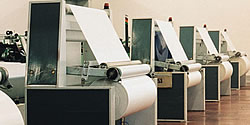 The TCX/A-170 represents the latest development of a consolidated range of cloth batchers manufactured by the company in Chignolo. It is an axial cloth batcher which is particularly indicated for Kevlar, carbon and above all glass fibre fabrics. Glass fibre fabrics are widely used in the electronic industry to produce electronic boards and microprocessors. They are also used in the aircraft industry, in the building segment as well as in the production of high-tech sport articles. It is a very delicate fabric, extremely fine and susceptible to various alterations which can impair functions, such as the weft distortions during the winding stage. These alterations are extremely difficult to correct in the weaving stage. Glassfibre fabrics are considered the most difficult fabrics to wind up: in addition, their high cost suggests particular attention during handling.
The TCX/A-170 represents the latest development of a consolidated range of cloth batchers manufactured by the company in Chignolo. It is an axial cloth batcher which is particularly indicated for Kevlar, carbon and above all glass fibre fabrics. Glass fibre fabrics are widely used in the electronic industry to produce electronic boards and microprocessors. They are also used in the aircraft industry, in the building segment as well as in the production of high-tech sport articles. It is a very delicate fabric, extremely fine and susceptible to various alterations which can impair functions, such as the weft distortions during the winding stage. These alterations are extremely difficult to correct in the weaving stage. Glassfibre fabrics are considered the most difficult fabrics to wind up: in addition, their high cost suggests particular attention during handling.
For these reasons, axial winding was preferred to tangential winding, which is more traditional and easier, yet generates higher stress on fabrics. In this case, the fabric roll is formed by rotating the fabric between two contact tangential rollers. The peripheral speeds of the two rollers are different in order to ensure the desired roll density. This is the classical cloth batcher of traditional design, which is available in different typologies (constant-tension, with accumulator, and so on).Unlike this model, the TCX/A-170 works with an axial drive and does not use tangential contact rollers. In fact, the axial drive is recommended when winding delicate, high-tech and (above all) slippery fabrics. In practice, the fabric is wound onto a small central beam which is axially driven by a motor. Obviously, the axial drive poses different and more difficult problems in terms of roll tension. There are different systems for modulating the roll tension, and each of them can influence the machine design.
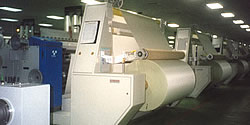 As already said, the main innovation introduced on the cloth batchers is the microprocessor-based control. Although being a recent creation, the cloth batchers by Formia Nuova have been sold in thousands of units all over the world, in particular in Asia, where the production of components for the electronic industry is particularly strong. The basic TCX/A-170 model takes advantage of three main elements, which once combined, ensure a continuous pulling action and constant and accurate winding (tension, pressure and braking). All systems are air-operated, with the obvious exception of the drive, a high-tech patented motor that works according to the Foucault law (therefore, based on speed rather than torque parameters). The fabric tension is adjusted by means of a conventional rocker motion with a weight which is maintained in parallel position with respect to the fabric. The fabric is then tensioned using the gravity force. The tension value is kept constant, except for the microprocessor-controlled model of the machine: in this case the tension value can be adjusted according to the fabric width. The pressure value is monitored by a roller coated with a special vulcanised material which is kept against the fabric roll. The roller pressure is not constant, but can be adjusted degressively (obviously, if desired, the pressure value can be also maintained constant over the whole winding time). This factor is very important because at the beginning of the winding process, when the fabric roll is still small and light, the pressure exerted on the beam must be higher and then decrease gradually (degressively) so as not to force the winding action excessively, and give rise to faults in the roll core.
As already said, the main innovation introduced on the cloth batchers is the microprocessor-based control. Although being a recent creation, the cloth batchers by Formia Nuova have been sold in thousands of units all over the world, in particular in Asia, where the production of components for the electronic industry is particularly strong. The basic TCX/A-170 model takes advantage of three main elements, which once combined, ensure a continuous pulling action and constant and accurate winding (tension, pressure and braking). All systems are air-operated, with the obvious exception of the drive, a high-tech patented motor that works according to the Foucault law (therefore, based on speed rather than torque parameters). The fabric tension is adjusted by means of a conventional rocker motion with a weight which is maintained in parallel position with respect to the fabric. The fabric is then tensioned using the gravity force. The tension value is kept constant, except for the microprocessor-controlled model of the machine: in this case the tension value can be adjusted according to the fabric width. The pressure value is monitored by a roller coated with a special vulcanised material which is kept against the fabric roll. The roller pressure is not constant, but can be adjusted degressively (obviously, if desired, the pressure value can be also maintained constant over the whole winding time). This factor is very important because at the beginning of the winding process, when the fabric roll is still small and light, the pressure exerted on the beam must be higher and then decrease gradually (degressively) so as not to force the winding action excessively, and give rise to faults in the roll core.
The fundamental parameter for the formation of special fabric rolls is the braking force of the pressure roller. The TCX/A-170 incorporates an electromagnetic brake, working like a clutch according to the degressive principle. This brake is operated by a tension variator: the initial value is set using a potentiometer, and then this value diminishes gradually following the weighing motion of the pressure roller. Therefore, this machine is designed to operate degressively in both the pressure and brake/clutch mode, as a result guaranteeing constant winding values for compact yet faultless fabric rolls.
L'intervento dell'elettronica
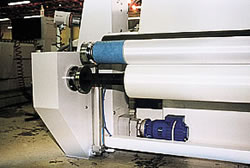 What is described above refers to conventional TCX/A-170 cloth batchers. Many of these machines have been sold to weaving mills all over the world. The wide experience of Formia Nuova has provided the basis for identifying a number of problems involving above all large-size weaving mills. The batcher was therefore re-engineered, and a new version was designed incorporating microprocessors and other important innovations. More and more often, Formia Nuova is required to supply machines to companies that have to run hundreds of looms, and a very high number of fabrics and variants at the same time. Therefore, it was necessary to design a machine model which could be adjusted in a simple and repeatable manner, and once adjusted, performs the whole winding procedure without further intervention and, above all, automatically monitors the pressure degressive action and the machine operation according to the pre-set value, as these parameters are decisive for the roll density. In addition, it was also necessary to ensure maximum rapidity when changing the fabric type, without having to reset the machine, and adjust the mechanical motions, with particular regard to the tensioning rocker motion. For this reason, the new machine model has been equipped with a microprocessors which, through a PLC, control the machines more efficiently. Obviously, the PLC allows the setting of degressive values (or of steps, if a step-like pressure decrease is desired).
What is described above refers to conventional TCX/A-170 cloth batchers. Many of these machines have been sold to weaving mills all over the world. The wide experience of Formia Nuova has provided the basis for identifying a number of problems involving above all large-size weaving mills. The batcher was therefore re-engineered, and a new version was designed incorporating microprocessors and other important innovations. More and more often, Formia Nuova is required to supply machines to companies that have to run hundreds of looms, and a very high number of fabrics and variants at the same time. Therefore, it was necessary to design a machine model which could be adjusted in a simple and repeatable manner, and once adjusted, performs the whole winding procedure without further intervention and, above all, automatically monitors the pressure degressive action and the machine operation according to the pre-set value, as these parameters are decisive for the roll density. In addition, it was also necessary to ensure maximum rapidity when changing the fabric type, without having to reset the machine, and adjust the mechanical motions, with particular regard to the tensioning rocker motion. For this reason, the new machine model has been equipped with a microprocessors which, through a PLC, control the machines more efficiently. Obviously, the PLC allows the setting of degressive values (or of steps, if a step-like pressure decrease is desired).
This re-engineering project of the machine, which is currently undergoing tests at the factories of some Italian companies, has allowed the creation of a number of setting programs according to the fibre type, which can be run automatically, therefore eliminating all manual setting operations. Obviously, the reliable and well-proven structure of the machine has been left unchanged. The original pneumatic adjustment system of the machine has been confirmed, and the mechanical motions are virtually the same as on the previous models: for example, the beam loading system is the traditional and highly reliable automatic (or manual) rotating self-centering V-type supports, and is provided with all safety measures imposed by Europea standards.
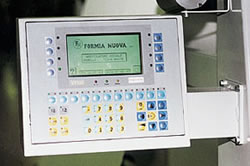 Also the fault detection lamps are the same as before. The machine incorporates two types of inspection lamps: the one is a neon lamp positioned behind the fabric in order to back-light the fabric and detect eventual weft distortions, while the other is a halogen spot installed in a slightly slant position to cross-illuminate the fabric surface and the weft. The new element is a console with keyboard, while the most important one is the PLC: at this level of the development procedure, the testing stage becomes essential as both components are rather sophisticated and powerful, however the target is the further industrialisation of the machine.
Also the fault detection lamps are the same as before. The machine incorporates two types of inspection lamps: the one is a neon lamp positioned behind the fabric in order to back-light the fabric and detect eventual weft distortions, while the other is a halogen spot installed in a slightly slant position to cross-illuminate the fabric surface and the weft. The new element is a console with keyboard, while the most important one is the PLC: at this level of the development procedure, the testing stage becomes essential as both components are rather sophisticated and powerful, however the target is the further industrialisation of the machine.
Downstream to the PLC, a set of proportional electrovalves has been introduced for the control of the pneumatic system. The rocker motion is also equipped with pneumatic cylinders, which eliminate the intrinsic limits of gravity adjustment. The pressure and clutch/brake values are adjusted by means of proportional electrovalves: in this case too, the manufacturer chose high-tech valves. The roll diameter is measured on the basis of the weighing motion of the pressure lever, which then commands the variation of the fundamental parameters (pressure, tension, braking) in order to check the winding process. In conclusion, the result is a large-size compact roll of tensioned fabric with faultless weft. All this can be achieved on several machines at the same time (even though these machines are processing different fabrics of different widths), and with minimum effort during the machine programming stage.
Technical features
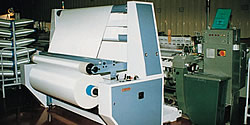 Winding method: Axial
Winding method: Axial
Maximum diameter: Ø1000
Minimum diameter: Ø100
Fabric type: Frabrics prone to weft distortion phenomena; Glassfibre fabrics for electronics, building aircraft,rovings,interior furnushings; Polyester and polyamide fabrics for architectural applications; Carbon fibre fabrics for various applications; Kevlar fabrics for industrial and military applications
Fabric width: 100-170 cm
Maximum weight: of roll 1600 Kg
Maximum fabric: tension 200 gr/cm
Winding up speed: 25..85 cm/min
Power supply: 400V 50 Hz - trifase + neutro +terra
Motors: Eddy current motors (Foucalt law) kw 0.37 4 P
Commands: Electronic keyboard and Siemens PLC
Fedding pressure: 6..8 Bar
© Copyrighted by Miller Freeman 2000
|
 |